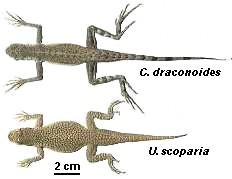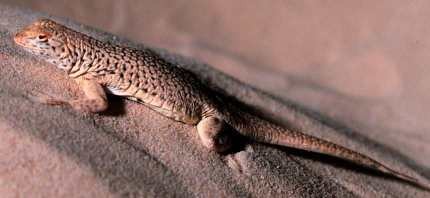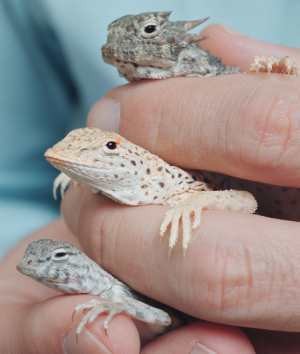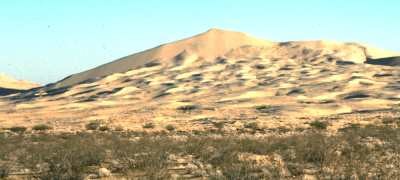Field Studies
Research Highlights
Comparative sprinting performance of the sand lizard clade: integrating laboratory and field studies.
Background

At right from top to bottom: Phrynosoma platyrhinos, Uma scoparia, Callisaurus draconoides. One advantage of working with sand lizards is that their phylogenetic relationships are well understood, and the morphology within this relatively small clade is quite diverse
We have concentrated first on comparing field and laboratory locomotor performance in two closely related species, Callisaurus draconoides and Uma scoparia. Callisaurus and Uma are ideal for clarifying the effects of morphology on escape locomotion because they have differing tail, limb and body dimensions, and they sometimes occur in the same microhabitat within a sand dune in Southern California (where we can estimate field speeds from measurements made on footprints).

Uma scoparia. Of all the genera of sand lizards, Uma appears morphologically and behaviorally most specialized for living on loose sand that typifies dune systems. Specialized scales form "fringes" on the toes of Uma, and elegant experiments by Carothers (1986) showed that these structures enhanced the sprinting performance of this species on sand. The head of Uma is also shovel-shaped to facilitate rapid burrowing into loose sand ("sand swimming").

The axial muscles in the neck, trunk and tail are all proportionately larger than other closely related species, and these structures are also used during sand swimming. We have recently obtained recorded muscle activity and movements of sand swimming, and we found that the axial structures can be vibrated faster than 30 times per second as these lizards bury themselves!


Uma scoparia footprints (traveling from right to left) on the sand of Kelso Dune in southern California. The hind feet generally leave larger footprints than the forefeet, and the footprints of the forefeet are nearer to the middle of the track. Note that the fifth toe often makes a small crescent-shaped impression behind and to the side of the hind footprint, and this can be used to help determine the direction of travel.

As these lizards move at slower speeds, the footprints become less circular. Categories of tracks are as in Jayne & Ellis (1998). The category 1 footprints shown above are for bipedal strides as a lizard sprinted from a standstill. Category 2 footprints are from running quadrupedally at a relatively fast speed. Categories 3 & 4 are slower speeds of quadrupedal locomotion.
Research Summary
The ability of organisms to sprint quickly may be critically important for effectively capturing prey, escaping predators and defending territories, and lizards have served as a model group for determining the sprinting capacities of terrestrial vertebrates. Lizards commonly live in habitats that vary spatially in incline, but the effects of incline on locomotor performance in lizards are poorly understood. Most previous studies of lizard sprinting performance have used level racetracks 1-3 m long and standardized laboratory conditions, but the ecological relevance of laboratory tests of locomotor performance often is unclear because of the lack of attendant field observations. Consequently, we have combined laboratory and field approaches to understand how inclines affect maximal sprinting capability in Callisaurus draconoides and Uma scoparia.
In the laboratory, we analyzed high-speed videotapes of lizards sprinting from a standstill on a sand-covered racetrack which was level or inclined 30 degree uphill. Callisaurus sprinted significantly faster than Uma on both level and uphill sand surfaces, although Uma is considered morphologically more specialized for sandy habitats. Overall, the effects of incline were more pronounced for Callisaurus than for Uma. For example, the incline caused a significant decrease in the maximum stride length of Callisaurus but not Uma. In addition, Callisaurus ran bipedally more often than did Uma on both the level and uphill surfaces. For laboratory data we used regression equations to calculate the relationship of stride length to speed, and these equations allowed us to estimate field speeds based of the stride lengths which were measured from footprints.
We also analyzed footprints from escape paths of Uma and Callisaurus on the Kelso sand dune system in Southern California to determine:
- maximal speeds of locomotion in nature,
- the amount of bipedal running,
- whether running was random with respect to inclines,
- whether inclines adversely affected speed, and
- the orientation of escape running with respect to features in the environment.

- Approximately 30% of the strides for Callisaurus were bipedal, whereas less than 10% of the strides of Uma were bipedal. Bipedal strides of Callisaurus averaged 12% longer (and faster) than quadrupedal strides.
- Overall the inclines traversed during the escape locomotion of both species were similar to the availability of inclines in the environment. However, Callisaurus appeared to have a threshold whereupon lizards ran horizontally on steep surfaces rather than directly up or down these slopes.
- Ignoring the first meter of locomotion, where lizards accelerate rapidly, the speed of Uma in subsequent meters was adversely affected by running both up and down steep inclines. In contrast, for Callisaurus, the only adverse affect of incline on sprinting speeds in the field was observed for the initial meter of the escape path.
- Uma frequently ran past nearby vegetation and burrows, and more than half of their escape paths ended in burrows that were heavily utilized (as indicated by a large number of lizard tracks). In contrast to Uma, the orientations of the initial portion of Callisaurus escapes were directed towards the nearest vegetative cover and far fewer escapes ended at burrows. Thus, even within the same micro-habitat, these two species differ in some aspects of their tactics for escaping.